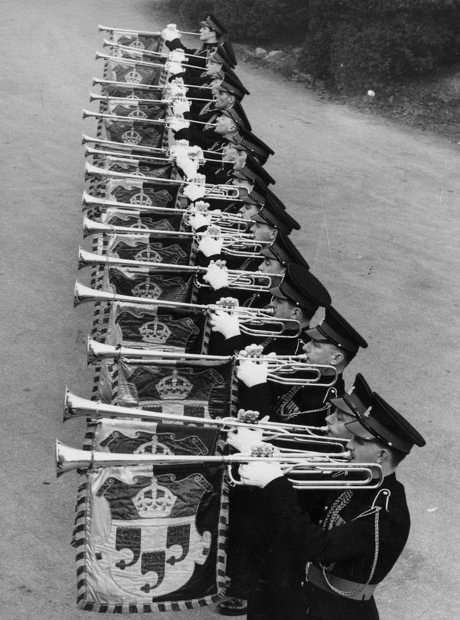The Fanfare Trumpeters of the Royal Air Force have been entrusted with the coveted role of heralding His Majesty King Charles III at His coronation on 6 May 23.
.jpg)
Armed with the finest state-of-the-art instruments, hand-made by Richard Smith of Smith-Watkins Trumpets, the team will sound fanfares and add extra sparkle to several works throughout the ceremony. These will include Gordon Jacob’s infamous rendition of God Save the King, written for the Coronation of Her Majesty Queen Elizabeth II in 1953, and Hubert Parry’s I was Glad, including the ‘Vivats’!
Humans have long found ways to communicate through organised noise, or what we often refer to as ‘music’. This may have first been through vocal noises, beating the chest or tapping objects together. However, the mind still boggles at where, and who, first vibrated their lips or ‘blew a raspberry ’into a vessel or horn to make that first trumpet sound.
Since this moment, infinite trumpet-like instruments have been used in every corner of the globe to herald important dignitaries, occasions, calls to prayer or relay battle orders.

Why might this be? Well, blowing that ‘raspberry ’into a tube with an opening flare at the end, similarly to that of a loudspeaker, can project sound waves that travel vast distances. Many of these, such as the conch shell, steer horn, didgeridoo, and alpenhorn are still used to great effect.
The earliest known metal trumpets were allegedly found in Tutankhamun’s tomb made of sterling silver and bronze. Instruments such as these and Roman equivalents closely resemble the fanfare trumpets we use today. Adjusting the tension of one’s lips and changing mouth shape allow a limited variety of pitches to be produced. This is the technique still used on modern bugles, where at least 5 notes can be achieved on the lip to sound calls such as the Sunset, Last Post and Reveille. Even more can be created on the Eb Herald Trumpets played by the State Trumpeters of the Household Cavalry.
The only way these historic instruments have evolved into the fanfare trumpets which will be used on the Coronation, is the addition of valves and their subsequent tubing, allowing a far greater choice of notes for composers to have at their disposal.
The first coronation for which three-valved fanfare trumpets were used was that of King George VI in 1937. Inspired by single-valved trumpets used in performances of Verdi’s opera Aida, Lieutenant Colonel Adkins, Royal Military School of Music (RMSM), Kneller Hall, commissioned instrument manufacturer Hawkes & Co. to produce three-valved versions. As a result, sixteen trumpeters from Kneller Hall sounded the fanfare on these new trumpets, including the King’s Fanfare and introduction to God Save the King written by Sir Henry Walford Davies, former Principal Director of Music (RAF), and composer of the RAF March Past.
.jpg)
Since this moment, fanfare teams using the three-valved trumpets have become common place welcoming world leaders across the globe with works composed by some of the most highly regarded composers including Sir Arthur Bliss, Ralph Vaughn Williams, Malcolm Arnold and John Williams.
A standard fanfare team across the British military most commonly consists of seven players. Trumpeters play four higher-pitched instruments, and two tenors and a bass are usually played by trombonists. The instruments appear ‘stretched-out’ compared to regular trumpets and project a direct fanfare-like sound. They are carefully designed so that all seven instruments are the same length (mouthpiece to bell flare), fitting the same crested banners to create perfect symmetry and splendour.
Performing on these instruments does present several challenges. Being so far away from the bell where the sound comes out means it takes time to accustom to dynamics and hearing oneself. Also, holding the long instruments up for any length of time, in what is essentially a stress position can be tiring. The felt banners are heavy, therefore it is always advised that composers keep the fanfare trumpeters in the playing position for a maximum of 60 seconds, and that any rests allow time for the ceremonial drill movements involved in raising and lowering the instruments. Furthermore, when on ceremony you are always in the public eye for long periods of time before sounding a fanfare, so getting used to playing when you and your instrument are cold is crucial - any warm-up is a long distant memory. And if it’s a windy day, good luck keeping that mouthpiece on your chops!
Despite these challenges, the Fanfare Trumpeters of the RAF are experienced and world-renowned having performed at a number of high-profile occasions recently.
As a member of the Fanfare Trumpeters of the RAF, I felt privileged to play during the Thanksgiving Service of Her Majesty Queen Elizabeth II’s Platinum Jubilee at St Paul’s Cathedral. I also performed in Westminster Abbey during the Thanksgiving Service for the Duke of Edinburgh. It is a true honour to be performing for the coronation of His Majesty The King and to represent the Royal Air Force in this national celebration.
Performing for historic ceremonial occasions at St Paul’s Cathedral and Westminster Abbey always feels exciting. Being positioned in the high organ loft gives not only a profound sense of perspective to these events but also enhances the atmosphere, especially in the few moments of electric silence before performing the opening of the Fanfare to the National Anthem.
Sergeant Jonathan Hill,
RAF trombonist & Leader of the Fanfare Trumpeters of the RAF
Written By Air Specialist (Class 1) Alan Thomas, Royal Air Force Trumpeter









